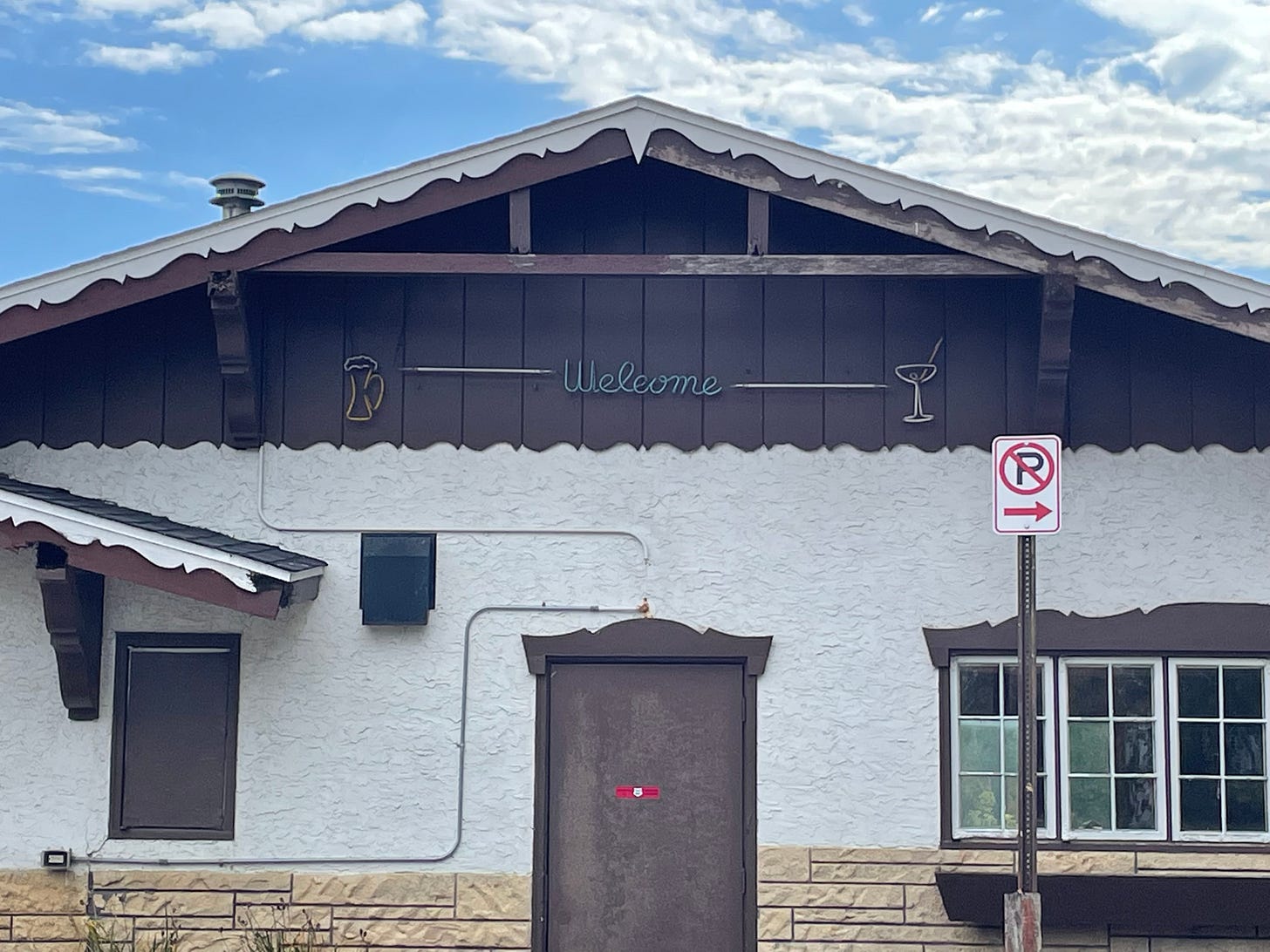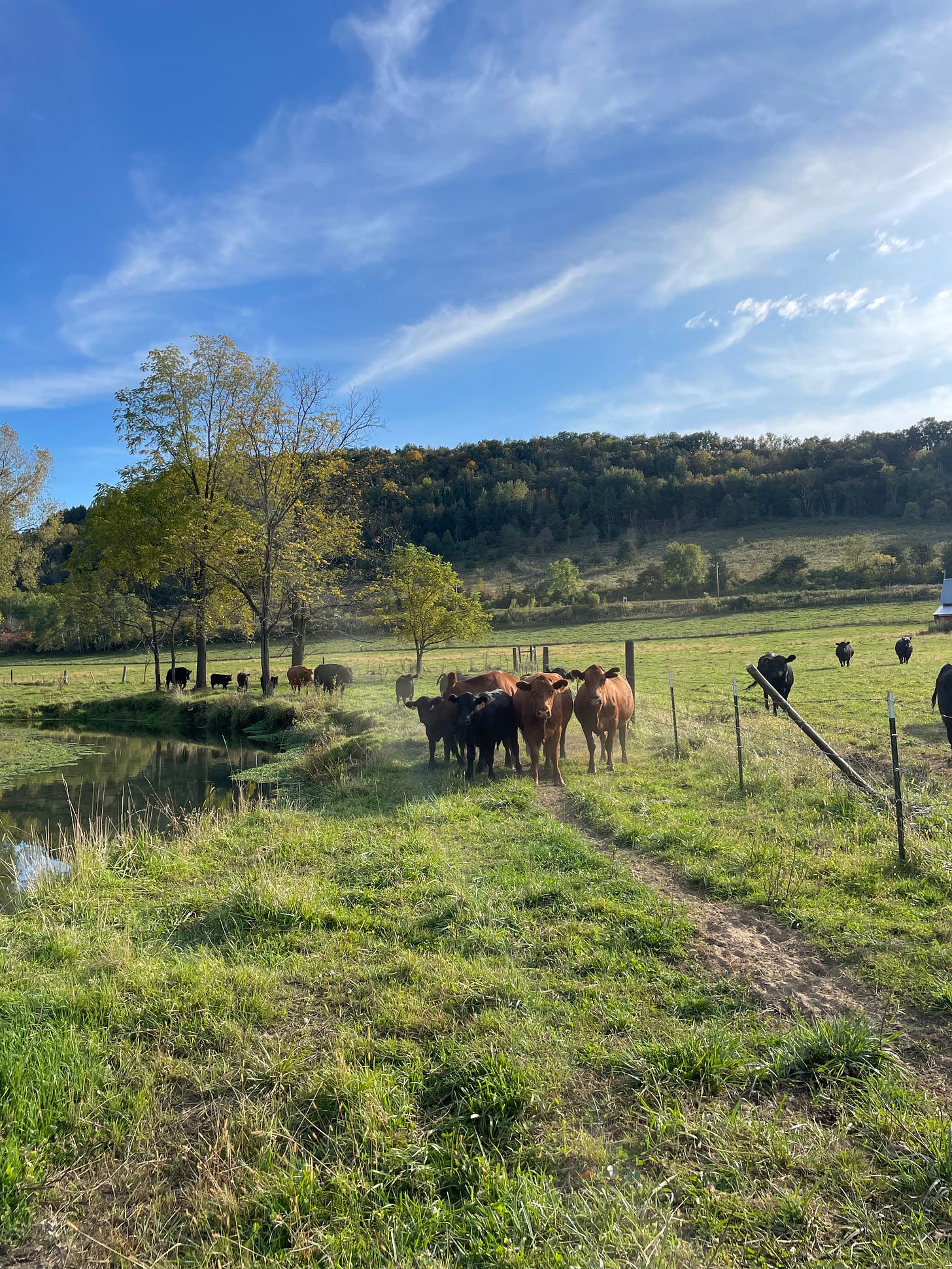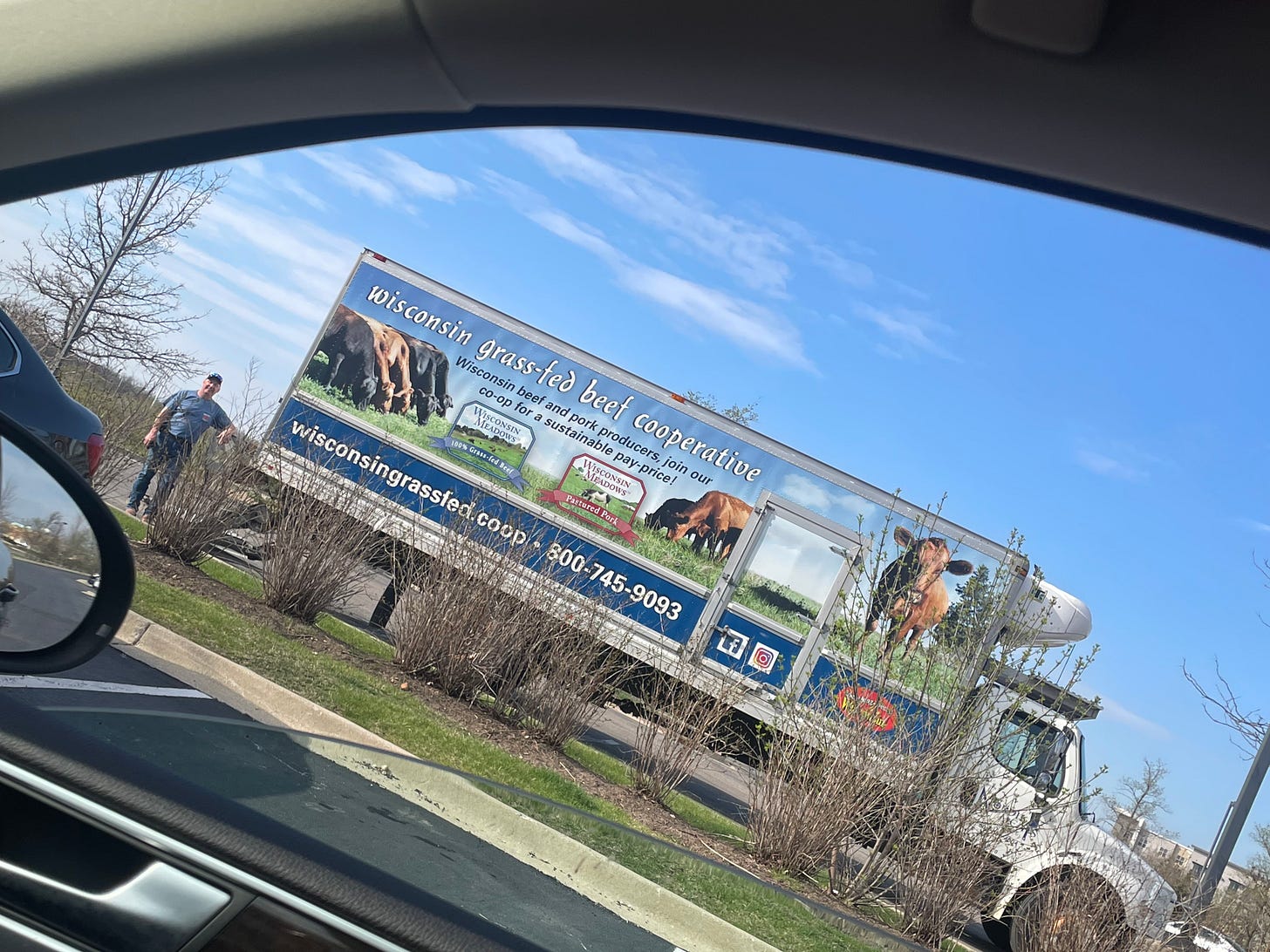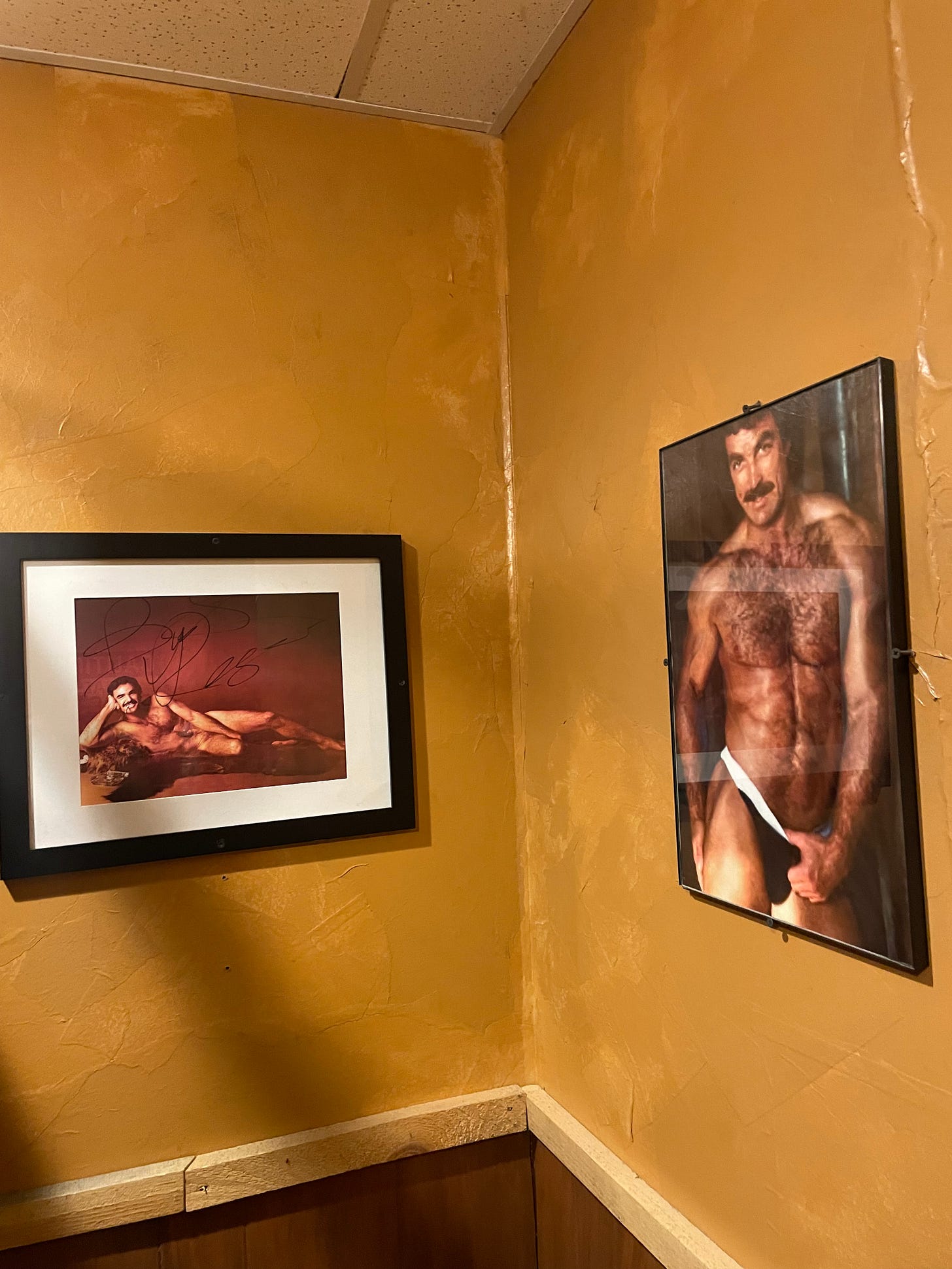Wisconsin charm.
As an East Coast native, I didn’t grow up with many ideas about the Midwest. Even after moving to Chicago, I had little sense of what lay beyond the city, my mind’s eye conjuring interminable corn fields and suburban landscapes out of John Hughes movies. I didn’t buy a car until 2019, six years after moving to Chicago, but since then I’ve tried hard to make up for lost time. I’ve visited St. Louis, Detroit, Milwaukee, and plenty of places in between. I’ve seen cornfields and suburbs, but I’ve also seen dunes, forests, prairie, and unique urban landscapes. Last fall, a friend and I drove a little over four hours northwest of Chicago to visit a ranch in the Driftless region of Wisconsin. The trip brought us into an unexpected geography and furthered my understanding of the logistics of producing grass-fed beef in the Midwest.
Healthy pastures at Willow Creek.
The Driftless area is so called because the region was not covered by glaciers in the most recent Ice Age. As glaciers receded in other areas, they left behind a deposit of sediment called “drift”. This drift covered the features in the land that existed before the glacier’s slow movement across it. While “glaciated” landscapes are defined by drift and moraines, the Driftless region reveals pre-Ice Age sandstone bluffs, narrow ridges, and coulees, or steep-sided valleys. Where the ridges are broad and plateau-like, you will see rows of corn and soy, along with conventional dairy farms, as in much of Wisconsin. Descend into the valleys, and space is tighter. The densely wooded ridges and marshy coulees are prime hunting territory, while the cold water streams found all over the valley beds are home to plenty of trout.
A natural water feature in one of Willow Creek Ranch’s pastures. Breeding is staggered so that half the cows calve in the spring and half in the fall. Several of these cows had just calved, or were about to. One had her calf while we were staying at the ranch!
I planned this trip to the Driftless to visit a rancher named Rod Ofte. His ranch, Willow Creek, is based in Coon Valley, WI, in between Viroqua and La Crosse, about 15 miles from the Mississippi River. I learned to butcher in the Midwest, and most of the farms I’ve worked with over the past ten years have raised their animals on a mixture of grazed grass, hay, and grain (typically corn and soy). This approach reflects the Midwest’s position as the grain producing heartland of the US as well as our short growing season, which makes raising ruminants like cattle, sheep, and goats on a diet of 100% grass a challenge. Most farms I’ve worked with raise their herd on pasture for the majority of their lives, and I feel good about the sustainability of these small farms. Not to mention, the meat has always been delicious - marbled, sweet, and tender.
But I wanted to see first hand how to do things differently, and I had heard from another farmer that Rod was the person to talk to if you wanted to learn about raising grass-fed beef in the Midwest. So on a stunningly sunny morning in early October, my friend and I got in our cars, fought past O’Hare-bound traffic, droned through an hour or two of monotonous highway, and made our way towards the Driftless. It was the golden hour when we arrived, taking a sharp turn off the country highway and descending swiftly to the valley floor. A red barn, its roof covered in solar panels, stood out in wash of lush green. Just a few trees along the ridge lines had begun to turn, and some of the corn fields had been mown down, the only signs that it wasn’t midsummer.
We arrived at the main farm property a bit before Rod did, and we were greeted by a pair of turkeys, a barn cat, and a free roaming Kune-Kune pig named Lettie (or Laddie? or Lottie?). I already felt a little high on the clean air, the sound of the babbling brook, the sight of brand new calves and their mamas dotting the bed of the stream, and the sense of being tucked away in this valley, which somehow felt worlds away from the landscape of cornfields at the top of the road we’d just careened down. Rod rents out a two bed trout cabin on the property, in addition to a guest house complete with a television and jacuzzi tub in the master bathroom. The big house was available, so we had arranged to stay on the farm, and we started unpacking our cooler of groceries and a case of Moon Man’s we’d picked up at a Whole Foods outside of Madison. The FX show The Bear had premiered earlier that summer, and I had brought fixings to make chicken piccata, a dish the show had made cool again.
Dinner was delayed by Rod’s arrival and immediate proffering of pints from the keg in his office, which was located in the back end of the guest house where we were staying. On the front porch in the fading evening light, Rod shared some of his story with us - a fourth generation native to the area, a West Point grad, a former international business man who had split his time between Philadelphia and Munich, and now a cattle rancher, with goals to get his ranch to carbon neutral. He pointed out a spring-fed stream running next to the house, and showed us where he’d installed a pump that dispensed the delicious, potable spring water. He proudly informed us that he had fiber optic internet and that it was probably faster than what we were used to, even in the big city. And he grilled us a bit on what we were doing there - I told him I was a butcher, described my training and experience, walked him through what the CMC does. I must have flexed just enough, because Rod took us seriously. Our pints were refilled, and he laid out a plan for the next day: tour of the pastures, tour of the processing plant, steak dinner.
Buckled into the UTV, enjoying Wisconsin’s state beverage, a Spotted Cow from New Glarus.
The next afternoon found us strapped into a UTV clutching cans of New Glarus beer, Rod at the steering wheel. We passed the paddock where the market weight cattle are held, eating hay for a few days before they go to the plant. A stone’s throw away, we parked and stepped over electric fencing into the deep grasses of the paddock we had seen on our drive in, the one full of cows and their calves grazing along the banks of a trout stream (two men were fishing at the edge of the pasture near the road and gave us a wave). Rod’s herd is mostly black Angus and Belted Galloway, with the occasional outlier, a red hide here, dappled gray and brown there. Belted Galloways, sometimes referred to as belties, have a reputation for thriving on grass, whereas many strains of American black Angus have been so conditioned to finish on grain, their genetics have begun to favor it. Rod breeds half of his herd to calve in the spring, and the other half to calve in the fall, spreading out the activity to make it more manageable while ensuring that a number of cattle reach market weight all year round. Most of the cows in this paddock are bred and about to calf or have just calved, and we are crossing our fingers that we might get to meet a newborn today.
Olivia in the Nordik Meats locker.
After checking on one of the cows who Rod thinks might calve this afternoon, we get back in the UTV and traverse another meadow, one of the hayfields. Rod doesn’t rotate his herd every day, but he does practice a form of adaptive multi-paddock grazing, moving the herd according to the robustness of the grasses, the level they’ve been grazed, water concerns (drought, flooding), and the seasons. Rod points to a section of the creek that had recently experienced a 100 year flood, the damage from which he and the young farmer that works with him have been working for months to repair. Some pastures might see a portion of the herd for a few days, and then rest (no grazing) for twelve months. Ample rest, strategic grazing, and animal inputs keep these pastures producing quality hay that can sustain the herd through the winter when snow covers the ground, while improving soil quality and biodiversity.
We pass a neighbor’s cornfield, which Rod describes as an ill-fated attempt to row crop land down in the valley that would be more suited to grazing and haying. He and his neighbor have reached an agreement, and next year the herd will graze here. We visit a deep, vibrantly blue pool along the creek, and Rod tells us if we approach carefully and quietly enough we should be able to see the trout. We approach as gingerly as we know how, but the trout dart out and disappear when we’re still several feet away. And we’re off again, up on the road and going what feels like 50 mph. We swing by Rod’s house for more beers, and then we’re back on the main road, climbing up to the top of the ridge. We wave at cars (and tractors) that pass by as we make our way towards Nordik Meats, a federally (USDA) inspected processing plant that Rod helped open and now helps to manage.
Nordik opened in the spring of 2020, the knick of time given the pressures that the pandemic placed on our food systems. Built from a former slaughterhouse and butcher shop that had closed years before and was sitting vacant, Nordik provides a vital service for the local community of livestock farmers. The team works through about 20 head of cattle a day when the kill floor is operating, usually about three days a week. Their chilling room holds around forty carcasses, split in sides, and the adjacent aging room holds about forty five. A rail system runs from the kill floor into the chilling room, looping back and forth to create tight rows of hanging space, then into the aging room, and then finally back out the other side, to the cutting room. A team of brothers swiftly breaks sides of beef (as well as hogs and the occasional lamb) into primals and subprimals, which they toss with frightening ease towards the band saw that sits at one end of a long cutting table. Along each side of the table there are three or four sets of knife-wielding hands, ready to trim and shape each hunk of meat that comes their way. By the end of the table, each subprimal has become a recognizable cut, whether it’s a T-bone, fajita meat, short ribs, or beef shank. An impressive grinder glugs down tubs of trimmings resulting from this butchery process, taking down 30 or 40 pounds at a time and spitting out perfect, 16 ounce squares.
I spent some time on the cutting table at Nordik Meats.
Nordik also comprises a small smokehouse where they make hams, ribs, pulled pork, bacon, jerky, and more. Sausages are made in house for their clients, which include small farmers who might bring a few cattle a month, and brands like Wisconsin Meadows and Wild Pastures that might bring in ten to fifteen head of cattle or hogs a week. The Driftless region is home to a lot of livestock farming, though as in many agricultural regions in the US there is a trend of consolidation of small farms and an increase in row cropping, which threatens smaller farms. While the area has better access to slaughter options than some other farming regions, many of the local processors are not federally inspected, which restricts the sale of the meat to within Wisconsin’s borders. USDA inspection enables farmers to sell beyond the state and to expand their wholesale business, providing more avenues for growth. Access to state or federally inspected slaughter is a well-documented bottleneck for smaller livestock farmers, and plants like Nordik are an important part of the solution.
Rod meeting me outside Chicago with the side of beef I ordered for meat shares.
When we had finished our tour at Nordik Meats, Rod showed us another pasture, where we met one of his bulls and more contentedly grazing cows. That evening back at the guest house, I made garlic-y kale and served caponata and some local cheese with a bit of sourdough; Rod grilled some dry-aged porterhouse steaks from his own beef. The next day it was time to leave, and I was already scheming my return.
I’ve had the opportunity to work with both Nordik Meats and Willow Creek again over the past few months. Our initial tour of the plant in October made me realize how far removed my years of butchery had been from an experiential understanding of slaughter. Joel, who runs the daily operations at Nordik, was kind enough to agree to having me shadow the team for three days, so in mid-November ‘22 I drove back up alone, checked into an airbnb, and set my alarm for 6am. The fields were bare and frosty, and there was snow in the forecast. The first night in the airbnb, I rewatched the film Temple Grandin (2010), which I hadn’t seen since it was released. It was dawning on me that, apart from my brother and our friend killing a kid goat with a hand gun on a beach in Maine in 2013, I had never seen a slaughter.
For three mornings in a row, I spent a few hours on the kill floor. It all happens in a high ceilinged room, which is well lit and unexpectedly warm and humid. A small radio hums under the white noise as the members of the small, efficient slaughter team carry out their individual roles. Overall the energy is even and subdued. The most jarring sound is the discharge of the captive bolt stunner, which is heard three or four times an hour when an animal is “knocked” or rendered unconscious. Nordik is dedicated to humane slaughter and animal handling, but there are still moments that tie my stomach up in knots. The animals wait their turn in a pen, and one by one the handler coaxes them into a chute that leads to the knock box. They are mostly calm, though some have to be prodded forward to fully enter the box, and as the metal door slides behind them they kick and low, deep and loud. The kill floor team is comprised of a handler, someone who does the knocking and bleeds the animals, a team of two who skin and eviscerate, and a team of two who split the carcasses and inspect them for any bits of hair and fecal matter, spraying the carcasses with a vinegar solution to kill off E. coli and other bad bacteria during their hanging period, which can last ten or more days.
For the first hour or more, I stand on the periphery in rubber soled boots, a heavy rubberized apron, and a Nordik Meat’s baseball cap. At first my nervous system is a little overwhelmed by the sounds, the heavy thud of the animal hitting the knock box floor, the damp heat which I now understand is given off by the bodies of living and just-dead animals and the gallons of hot blood spilling on the floor, plus the spray from hoses washing manure, blood, and hair off of cow tails and aprons and into the floor drain. There’s a slight smell of manure with a bitter edge and a sweetness right behind it. Eventually I begin to grasp the flow, understand the pace, register the solemn but relaxed energy shared by everyone in the room. I ask if I can try my hand at skinning, the only step in the process where I might be able to apply my butchery skill set.
On the kill floor at Nordik Meats, skinning.
Having a knife in hand, pressing it to the hide and gauging the pressure and angle needed to cleanly separate the hide from the flesh beneath it, is instantly engrossing. I’m not instantly proficient at it, but it feels familiar and even fun. My left hand holds the hide taught, and it’s heavy. My shoulder aches after just a couple minutes. But it’s grounding to be an active part of the experience. Michael, Nick, and Pablo give me pointers, and they show me where to break the ankle joints, removing the hooves. By the time I’ve worked one side of the hide most of the way down, I’m sweating. This is hard work, work that the team seems to do with a casual effectiveness. While passively observing the slaughter, I had the heavy feeling of bearing witness. Picking up a skinning knife reminds me that every person involved in this process has an opportunity to leverage their skills in honor of each animal’s life. Connecting the dots from the Boos block butcher table where I spent years breaking down animals and trimming cuts for customers all the way back to the beginning of the process, I’m hit by the massive amount of labor required to get meat to the table. To contribute to the effort as a temporary part of this team is a privilege.
Ribeyes from the Willow Creek Ranch beef for our meat shares.
This past April, I bought a side of beef from Willow Creek Ranch, and coordinated with Rod to pick it up from a suburb near Chicago where he was doing other deliveries. I had pre-sold the beef as part of a program I offer about once a month through the Chicago Meat Collective. Featuring different farms and types of meat (beef, pork, and lamb), we sell whole or partial animals in “shares,” a bulk buying option that allows me to utilize the whole animal while offering our customers a variety of steaks, roasts, and ground meat and bones that reflects my entire yield. Transparency and a shortened supply chain are also goals of this project, and it was gratifying to get beef from a farm I had visited, that was slaughtered by hands I knew, using methods I now understood more thoroughly.
I reached out to Joel again a few months ago to ask if he’d be willing to allow a former co-worker of mine come shadow at the plant. He generously agreed for Brian to spend at least a week at the plant, complete with a UTV tour of the Willow Creek pastures with Rod. This morning, he got to see his first slaughter; yesterday he learned to link sausages. We spent a couple hours on the kill floor this morning, Brian observing while the team worked through several head of cattle. Michael, Nick, Pablo, Brittany, and much of the same crew I met last November are still here, and Pablo let me borrow his knife to do some skinning. I’m excited to hear what Brian makes of this experience, and I will follow up in a future post. My hope is to continue partnerships like this, where the CMC helps facilitate mini-internships with slaughterhouses around the Midwest. Few experiences offer a better context for understanding the labor, skills, and logistics that underpin the local agricultural economy here and anywhere small farms and small processors exist. I look forward to sharing it with more people.















What a great read!
An amazing deep dive into the multi-layers and processes that are behind the perfect steak on your BBQ grill.